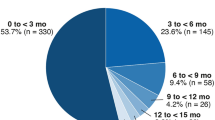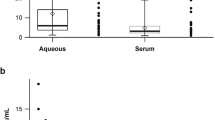Abstract
The aim of this study was to evaluate the long-term effect of intravitreal ranibizumab on the retinal nerve fiber layer (RNFL) in exudative age-related macular degeneration (AMD). Patients with treatment naive neovascular AMD in one eye were enrolled into the study. Following 3 monthly intravitreal ranibizumab injections, the patients were evaluated according to disease activity and re-injections were performed according to “treat and extend” protocol. During the follow-up, peripapillary nerve fiber layer thickness measurements were compared with normal fellow eyes. Forty-four eyes of 11 women and 11 men with the mean age of 66.3 ± 8.8 years (50–80) were enrolled into the study. All patients had completed at least 12 months of follow-up time. Patients received an average of 4.7 (3–11 injections) intravitreal injections. At baseline, no significant difference was observed between two groups for RNFL thickness, which was assessed as quadrants (p = 0.250–0.944) and globally (p = 0.814). In each group, there was a significant RNFL thinning (p = 0.009 and 0.022) after the third month, whereas no significant difference was observed between treated and untreated eyes. Patients were also classified according to the number of injections, and RNFL thickness showed no difference between eyes treated with less or more than five intravitreal injections (p = 0.757–0.973). Although there was no statistically significant difference in RNFL thickness between study and control eyes during 12 months of follow-up, a significant thinning was recorded in both groups compared with baseline values. Cross-sectional images with higher resolutions and precise segmentation opportunities are needed to investigate the hypothesis “VEGF neutralization and inhibition of cell maintenance” in detail.



Similar content being viewed by others
References
Eye Diseases Prevalence Research Group (2004) Causes and prevalence of visual impairment among adults in the United States. Arch Ophthalmol 122:477–485
Bressler NM, Bressler SB, Fine SL (1988) Age-related macular degeneration. Surv Ophthalmol 32:375–413
Lim LS, Mitchell P, Seddon JM, Holz FG, Wong TY (2012) Age-related macular degeneration. Lancet 379:1728–1738
Tolentino M (2011) Systemic and ocular safety of intravitreal anti-VEGF therapies for ocular neovascular disease. Surv Ophthalmol 56:95–113
Breen CE (2007) VEGF in biological control. J Cell Biochem 102:1358–1367
Nishijima K, Ng YS, Zhong L et al (2007) Vascular endothelial growth factor-A is a survival factor for retinal neurons and a critical neuroprotectant during the adaptive response to ischemic injury. Am J Pathol 171:53–67
Zhang SH, Yi Q (2009) Effect of VEGF-B on neuroprotection in mouse retinal ganglion cells. Zhonghua Yan Ke Za Zhi 45:38–42
Saatci AO, Oner FH, Arikan G (2011) Immediate intraocular pressure rise after intravitreal injection of ranibizumab and two doses of triamcinolone acetonide. Int J Ophthalmol 11:402–405
Bakri SJ, Pulido JS, McCannel CA, Hodge DO, Diehl N, Hillemeier J (2009) Immediate intraocular pressure changes following intravitreal injections of triamcinolone, pegaptanib, and bevacizumab. Eye 23:181–185
Gismondi M, Salati C, Salvetat ML, Zeppieri M, Brusini P (2009) Short-term effect of intravitreal injection of Ranibizumab (Lucentis) on intraocular pressure. J Glaucoma 18:658–661
Bakri SJ, McCannel CA, Edwards AO, Moshfeghi DM (2008) Persistent ocular hypertension following intravitreal ranibizumab. Graefes Arch Clin Exp Ophthalmol 246:955–958
Kahook MY, Kimura AE, Wong L, Ammar DA, Maycotte MA, Mandava N (2009) Sustained elevation in intraocular pressure associated with intravitreal bevacizumab injections. Ophthalmic Surg Lasers Imaging 40:293–295
Kilic U, Kilic E, Jaerve A (2006) Human vascular endothelial growth factor protects axotomized retinal ganglion cells in vivo by activating ERK-1/2 and Akt pathways. J Neurosci 26:12439–12446
Brar VS, Sharma RK, Murthy RK, Chalam KV (2010) Bevacizumab neutralizes the protective effect of vascular endothelial growth factor on retinal ganglion cells. Mol Vis 16:1848–1853
Seth RK (2009) Assessment of optic nerve cup-to-disc ratio changes in patients receiving multiple intravitreal injections of antivascular endothelial growth factor agents. Retina 29:956–959
Horsley BM, Mandava N, Maycotte AM (2010) Retinal nerve fiber layer thickness in patients receiving chronic anti-vascular endothelial growth factor therapy. Am J Ophthalmol 150:558–561
Martinez-de-la-Casa JM, Ruiz-Calvo A, Saenz-Frances F et al (2012) Retinal nerve fiber layer thickness changes in patients with age-related macular degeneration treated with intravitreal ranibizumab. Invest Ophthalmol Vis Sci 53:6214–6218
Girkin CA, McGwin G Jr, Sinai MJ et al (2011) Variation in optic nerve and macular structure with age and race with spectral-domain optical coherence tomography. Ophthalmology 118:2403–2408
Bendschneider D, Tornow RP, Horn FK et al (2010) Retinal nerve fiber layer thickness in normals measured by spectral domain OCT. J Glaucoma 19:475–482
Kim EJ, Hong S, Kim CY, Lee ES, Seong GJ (2011) Attenuated age-related thinning of peripapillary retinal nerve fiber layer in long eyes. Korean J Ophthalmol 25:248–251
Rouvas A, Liarakos VS, Theodossiadis P (2009) The effect of intravitreal ranibizumab on the fellow untreated eye with subfoveal scarring due to exudative age-related macular degeneration. Ophthalmologica 223:383–389
Gamulescu MA, Helmig H (2010) Lack of therapeutic effect of ranibizumab in fellow eyes after intravitreal administration. J Ocul Pharmacol Ther 26:213–216
Acknowledgments
This work was performed at the Department of Ophthalmology, Dokuz Eylul University Medical School, Izmir. It was not presented before in any scientific organization, and we did not get any Grants and funds as support for this study. We do not have any financial interests related to this work.
Author information
Authors and Affiliations
Corresponding author
Rights and permissions
About this article
Cite this article
Parlak, M., Oner, F.H. & Saatci, A.O. The long-term effect of intravitreal ranibizumab on retinal nerve fiber layer thickness in exudative age-related macular degeneration. Int Ophthalmol 35, 473–480 (2015). https://doi.org/10.1007/s10792-014-9972-2
Received:
Accepted:
Published:
Issue Date:
DOI: https://doi.org/10.1007/s10792-014-9972-2




